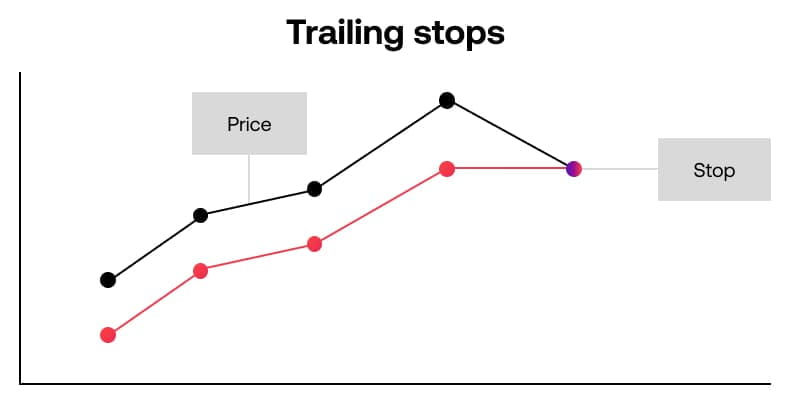
Stop-loss orders are a crucial tool for managing risk as you trade. Learn all about stops here – including what guaranteed and trailing stops are, and where to place your exit orders.
What is a stop loss?
A stop loss is a type of trading order that you can use to close a position if it moves against you. Unlike market orders, with a stop loss you set a specific level at which you’d like your position to close, and your trading provider will execute the order if it hits that level.
You set a stop loss at a price which is worse to you than your market’s current price. Depending on whether you’re long or short, this will be above or below market’s current level.
- On long trades, your stop loss will be below the current market price
- On short trades, it will be above the current market price
Want to automatically close a trade when it moves in your favour instead? You’ll need to use a limit order.
What is a limit order?
A limit order is the opposite of a stop loss – it automatically closes your position at a set level of profit. Because of this, you’ll often see limit orders referred to as ‘take profits’. They’re not as important to your risk management as stop losses, but remain a useful trading tool.
Limits help eliminate the risk of a position reversing before you close it, lowering your profit or potentially turning into a loss.
Learn more about managing your trading risk.
Why use stop losses?
Stop losses are a key part of your risk management strategy. They enable you to set the maximum potential loss from a trade ahead of time and remove the human error from closing losing positions.
Before you enter any trade, you should know your two possible exit levels:
- Your profit target, or where you’ll exit a winning position
- Your maximum loss, or where you’ll exit a losing position
This helps you take some of the emotion out of your decision making when capital is on the line. You can ensure that each opportunity fits your trading plan and set up your parameters when you should be at your most rational – before you’ve opened the position.
However, setting your exit points is only the beginning, and actually executing them can be tricky. You’ll have to contend with trading psychology, which often sees new traders rush to close winning trades and hold on to losing ones. Plus, you’ll have to time your exit in potentially volatile markets – and deal with distractions that may mean you’re not even at your trading desk.
If you’re trading 24-hour markets like forex or indices, then your market might move beyond your maximum loss while you aren’t even conscious.
Stops and limits help automate this process, taking the guesswork out of exiting positions. Instead of relying on your wits when closing positions, you can set your exit orders ahead of time.
Find out more about exit orders.
Types of stop loss
There are three main types of stop-loss order you’ll encounter when you’re trading. Up until now in this article, we’ve mostly covered standard stop losses – but you can employ guaranteed stops and trailing stops in your trading too.
Before we move onto those, though, let’s take a closer look at how stops work.
How standard stop losses work
As we’ve seen, you set a standard stop at a set distance from your chosen market’s current level. With City Index, you can choose to set your standard stop at a designated level, points of loss or loss in your base currency.
Say, for example, that you’re selling 10 Gold (per 1) CFDs at 1,700 and you’ve decided that your maximum loss is $200. Your 10 CFDs will earn or lose you $10 for every point that the precious metal moves, so you can set your stop loss:
- At 1,720
- At 20 points of loss
- At a loss of $200
Standards stops won’t necessarily always execute at these levels, however, due to slippage. Slippage is the risk that your market moves beyond your stop level before your trading provider can execute the order – meaning you take on additional loss.
If you want to remove the risk of slippage from your trading, you’ll want to upgrade to a guaranteed stop.
What is a guaranteed stop?
A guaranteed stop is a type of exit order that will always execute at the level you set. Other than this extra feature, they work exactly like standard stops – except you pay a premium if your stop is triggered (standard stops are completely free to use).
Essentially, a guaranteed stop works like a form of insurance on your exit order. Your trading provider agrees to cover the difference if your stop is hit by slippage, and in return you pay a premium.
Limit orders can’t be affected by slippage, so there are no guaranteed limits.
What is a trailing stop?
A trailing stop, meanwhile, is an exit order that automatically follows your trade as it earns a profit – but locks in if the market reverses. Trailing stops offer a great way to protect against the risk of a position moving into profit, then retracing back to your stop loss.

When you place a trailing stop, you choose how points away from the market’s current level you want it to be – you can choose a set price or monetary loss. Then, if your market moves in your predicted direction, the stop moves too. If the market moves against you though, the stop stays put, closing your position if the market retraces by the number of points you set.
Say, for example, that we use a trailing stop 20 points away from our gold trade at $1,700. If gold moves up to $1,800, then our stop will move up to $1,780. If it then falls back to $1,650, your stop will close the trade at $1,780 – securing you 80 points of profit.
Choosing your stop loss
The best stop loss to use depends on several factors, including your trading plan, the current market conditions, and your attitude to risk .
In volatile markets, we’d always recommend using a guaranteed stop to limit the risk of slippage. However, you will need to be aware that the premium you’ll pay if the stop triggers will add to the loss on your position.
Trailing stops, meanwhile, can be hugely useful in strongly trending markets, enabling you to use a stop to capture profit instead of only preventing additional losses.
Whichever stop you use, it isn’t a good idea to rely on them entirely. Monitoring your trades is an essential part of trading, even if you have a stop in place. So we’d recommend downloading the City Index app to monitor your trades on the go.
Start trading with stops
You can access all the types of stop with a City Index account. Follow these steps to get started:
- Fill out our online application form and add some funds
- Open our online trading platform, or download our mobile trading app
- Choose which market you’d like to trade, and whether to go long or short
- On the deal ticket, set which type of stop you’d like to use
- Decide where to place your stop
- Open your position
You can also test out trading with stops using a free City Index trading demo account. This gives you virtual funds to put to the test against real markets, so it’s a useful way for beginners to see how markets work without putting up any capital.
However, your trading demo won’t feature slippage.
Where to place your stop loss
There’s no single hard and fast rule to where you should place your stop on a given trade. Instead, you’ll need to find a balance between giving your trade room to move without taking on too much risk.
After all, if you place a stop too close to your trade’s opening level, then the position could be closed before it has a chance to earn a profit. But place it too far away, and you’ll lose too much if the market moves against you.
There are, however, a few tried and tested methods when it comes to placing stops.
The 1% rule
The 1% rule states that you should never risk more than 1% of your total trade balance on a single opportunity. This way, you can afford to take 100 straight losses before you’ve wiped your account.
When it comes to placing stop losses, the 1% rule gives you a set maximum loss to go by. For example, if you have a trading balance of $10,000, then you’ll want your stop to be no more than $100 away from your opening level on any trade.
You don’t have to use 1%, either. If you’re happy taking on more risk, then you can up the percentage.
Support and resistance
Support and resistance levels are areas on a chart at which a market has reversed multiple times recently. If a support or resistance level is broken, it may signal that a new trend is forming – which makes them useful places to put a stop.
Say we’re planning on buying a market in the expectation that it will form a strong uptrend. If it moves down and breaks through a recent support level instead, it’s a good sign that our trade has failed – so by placing a stop loss there, we can automatically exit the position.
Risk-reward ratios
Before you start trading, you should set a risk-reward ratio as part of your plan. This dictates how much risk we’re willing to take on in return for potential profit.
A risk-reward ratio of 1-3 means that we expect three points of potential profit for every one point of potential risk. So, if we have a profit target 150 points away, we can place our stop loss 50 points in the opposite direction.
Most traders use all three of these techniques in conjunction when planning their exits. You can look at support and resistance levels to as potential areas to take profit or cut loss, then check whether that fits your risk-reward ratio – and use the 1% rule to size the position and refine your exit levels.





